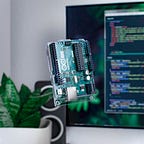How to set up ESP32-WROOM-32
Hey guys, this is going to be a quick guide on how to set up the ESP32-WROOM-32 board. This method is also applicable to some other ESP32 variants, but since I have an ESP32-WROOM-32 board with me, all the board pictures you will be seeing in this tutorial will be of that board.
We will just get straight into it and not bore ourselves with some technical details of the board. You can always read more or check the datasheet of the board to learn more about what you can use the WSP32-WROOM-32 to do or how powerful it is. I assume since you are here, you somehow have an idea of what the board is.
We need to get four things done: set up the Arduino IDE, get the board installed, get the driver installed, and test it out.
Arduino IDE Set-Up
There are lots of software packages that can be used for developing the ESP32 boards; we have the ESP HomeKit SDK, Arduino IDE, etc but the Arduino IDE is by far the easiest to get started with. If you don’t already have Arduino IDE installed, kindly download the software from the Arduino website, https://www.arduino.cc/en/software. After the download is done, install the software, and you are good to go.
Download the ESP32 Board
After having installed your Arduino IDE, you will need to install the board on your Arduino IDE so you will be able to select the board. To do this, go to File > Preferences and paste this URL in the additional board manager URL: https://dl.espressif.com/dl/package_esp32_index.json.
Once you are done doing this, go to the board manager on your Arduino IDE and search for ESP32 by espressif. Download the latest version of the board manager, and you are good to go.
Download the CP210x USB to UART Bridge VCP Drivers
You will need to download the CP210x USB to UART Bridge VCP Drivers for your computer to be able to read the ESP32 board. There are two drivers that ESP32 might be configured to use, but the ESP32-WROOM-32 is configured to use the CP210x USB to UART Bridge VCP Drivers. To download them, kindly go to https://www.silabs.com/developers/usb-to-uart-bridge-vcp-drivers?tab=downloads and select the driver for your computer type.
NOTE: If you are on some other variant of the ESP32, you might need the CH340 drivers.
Test-run the Board
Once everything is said and done, you are now ready to put the ESP32-WROOM-32 board to the test. Plug in the board to your laptop, and under board selection in your Arduino IDE, select the ESP32 Dev Module as the board. You can upload the blink example after connecting an LED to pin 13 of the ESP board. After compiling, make sure you hold down the boot button on the board so the code will upload.
Congratulations on getting your ESP32-WROOM-Board set up! I am currently running some RTOS tasks on my board; I should write about RTOS later on and how you can set it up on the ESP32. You can follow me to stay updated and get notified whenever that will be, but before then, HAPPY DEVELOPMENT.
Check out my YouTube channel where I make tutorials on how to send data from different development boards to different cloud services like GCP, AWS, Azure, Thingsboard, etc: https://www.youtube.com/playlist?list=PL6vSC9suLAKNBzQL8pG8CNiiyvvkX_ZUc
